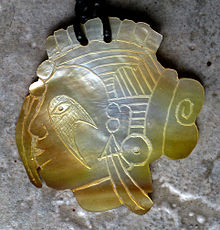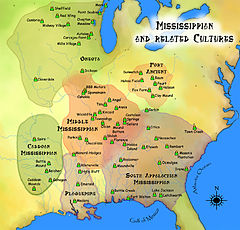- Shell gorget
-
A shell gorget is a Native American art form of polished, carved shell pendants worn around the neck. The gorgets are frequently engraved, and are sometimes highlighted with pigments, or fenestrated (pierced with openings).
Shell gorgets were most common in Eastern Woodlands of the United States, during in the Hopewell tradition (200 BCE–500 CE) and Mississippian cultural period (ca. 800–1500 CE); however, tribes from other regions and time periods, also carved shell gorgets. The earliest shell gorgets date back to 3000 years BP. They are believed to have been insignia of status or rank,[1] either civic, military, or religious, or amulets of protective medicine. Due to the placement of the holes in the gorgets, they are also thought to be spinners that could produce whistling sounds.[2]
Contents
Materials and techniques
Lightning whelk (Busycon contrarium) is the most common shell used for gorgets. Other shells, such as the true conch or Strombus, as well as freshwater mussels, are also carved into gorgets.[3] Today, due to environmental causes, harvested lightning whelks are significantly smaller than in precontact times. These earlier shells typically ranged from 6 to 12 inches in length.[3]
Harvested off the coasts of Florida and the Gulf of Mexico, the shells were traded through the Eastern Woodlands.[4] This native trade continued into the 16th century.[5]
Gorgets are carved from the penultimate whorl of the shell.[6] A blank is cut or broken out, then ground smooth. Holes for suspension and decoration are drilled, sometimes with a bow drills or chert drills.[3] The gorget forms a concave shape and, when engraved, the interior is polished and decorated.
While most gorgets are circular, some are shaped as rectangles with rounded corners, maskettes, or other novel shapes. An extremely elaborate pendant from Spiro Mounds is shaped as two hands connected by a common beaded bracelet.[7]
Archaic and Hopewell
Adena cultures created gorgets from slate and copper, but the Hopewell Exchange System brought exotic shells from the Gulf northward. Initially, Hopewellian peoples carved plain shell gorgets around 1000 BCE. Engraved gorgets appeared in the late Hopewell.[8] A Glacial Kame Culture marine-shell gorget from the Great Lakes dates from 1000 BCE and features an engraved bear or opossum with an umbilical cord.[9]
Mississippian
Mississippian shell gorgets were traded widely, common designs have a widespread geographical distribution. Calusa people of southern Florida harvested and carved gorgets.[10] Coiled rattlesnakes gorgets were found among the Guale Indians of Georgia.[11]
Mask gorgets, although rare, are found throughout the southeast, including Alabama, Tennessee, and Virginia. The masks have bas-relief noses, drilled eyes, engraved or drill mouths, and sometimes forked-eye motifs or zigzags under the eyes. Small shell cameos, under two inches wide, were found at Spiro Mounds.[12]
Iconography
Iconography on the shell gorgets comes from the Southeastern Ceremonial Complex. Extremely common designs include the triskele, coiled rattlesnake, water spider, chunkey player, and birdman, sometimes called a Falcon Inpersonater.
Native Americans, art historians, and anthropologists all have a wide range of often conflicting interpretations of the SECC iconography. Coiled rattlesnake gorgets were worn by young people and are believed to relate to age as opposed to status.[13] The forked-eye motif, commonly identified as markings from a peregrine falcon, references excellent vision and hunting skill among Muscogee Creek people.[14] "Strength of Life" design is interpreted by Kvokovtee Scott and Phillip Deer (Muscogee medicine man) as referencing a whirlwind and dancing movement.[10]
There are over 30 pre-contact examples of the Cox Mound gorget style, found in Tennessee and northern Alabama and dating from 1250-1450 CE.[1] The Cox Mound gorget style features four woodpecker heads facing counter-clockwise, a four-lopped square motif, and a cross within a rayed circle. The four-looped square, or guilloche, is considered by some to be a "whirling sun" motif, or a priestly or chiefly litter;[15] by some, the earth held up by cords to the Sky Vault at the four cardinal points;[16] and by others, the path of life with four stages of maturity. Woodpeckers are considered warrior birds among Cherokee and medicine birds that can extract illnesses among Muscogee Creeks.[15] The birds are also sometimes interpreted as the four winds.[1] The rayed circle or sun is interpreted literally, a deity or ancestors, council, and/or sacred fire.[1] The entire design could also illustrate the Yuchi myth of the winds.[1]
A gorget from the Castalian Springs Mound Site in Tennessee features a man holding a mace and severed head. This has been interpreted by some anthropologists as a "flying shaman."[17]
Some agreement can be found in interpreting the cross-in-circle design, which references the sun[10] and the ceremonial fire, fed by four logs aligned to cardinal directions. Another design widely agreed upon is the water spider with a cross-in-circle design on its cephalothorax. The spider gorgets illustrate a traditional story, common to many southeastern tribes from the Atlantic Coast to Missouri, about the water spider bringing fire to humanity.[15]
Historic gorgets
Turtle shells and stones have also infrequently been carved into gorgets. In the 18th century, metal medallions replaced shell gorgets among Eastern tribes.[18] In the late 19th century, women from tribes along the Colorado River, such as the Quechan wore defenestrated gorgets made from bivalve shells and strung on vegetal cordage.
Contemporary
Dan Townsend (Muscogee Creek-Cherokee) of Florida is the most widely recognized contemporary gorget carver. He is a self-taught carver but studied oral history under Seminole medicine woman, Mary Frances Johns.[19] He uses dental tools to carve shells with both traditional Muscogee Creek iconography and as well own representational artwork.[18] Muscogee Creek-Cherokee carver, Knokovtee Scott studied under tribal historians, traditionalists, and medicine men.[10] Scott carved gorgets with purple freshwater mussel shell harvested from near Fort Sill, Oklahoma.[18] Grady Smith (Muscogee Creek) from Florida draws on numerous sources for his shell gorgets,[20] including designs from Calusa wood carvings.
See also
- Long-nosed god maskette
Notes
- ^ a b c d e "Cox Mound Gorget." The Tennessee Encyclopedia of History and Culture. (retrieved 23 July 2010)
- ^ Dozier, Debye. "Northern, Eastern, and Southern Woodlands." Palomar College, American Indian Department. 16 June 2005 (retrieved 6 Feb 2011)
- ^ a b c Dreiss, Meredith L. "Marine Shell Ornaments, Icons and Offerings." Texas Beyond History. (retrieved 24 July 2010)
- ^ Dubin, 154
- ^ Dubin, 163
- ^ Fundaburk and Foreman, Pl. 155-6
- ^ Dubin 162
- ^ Dubin 159
- ^ Dubin, 156
- ^ a b c d Dubin, 202
- ^ Dubin, 200
- ^ Fundaburk and Foreman, Plates 157 and 158
- ^ Dubin, 161
- ^ Dubin, 163
- ^ a b c Dubin, 204
- ^ Townsend and Sharp, 208
- ^ Dubin, 196
- ^ a b c Power (2007), 214
- ^ Fauntleroy, Gussie. "Tradition! Arts and Crafts Revived." Native Peoples Magazine. 1 Dec 2005 (retrieved 23 July 2010)
- ^ White, Matt. "Art on the Terrace." Wakulla Wildlife Festival. 4 Dec 2010 (retrieved 23 July 2010)
References
- Dubin, Lois Sherr. North American Indian Jewelry and Adornment: From Prehistory to the Present. New York: Harry N. Abrams, 1999. ISBN 0-8109-3689-5.
- Fundaburk, Emma Lila and Mary Douglass Fundaburk Foreman, ed. Sun Circles and Human Hands: the Southeastern Indians - Art and Industry. Tuscaloosa: University of Alabama Press, 2001 (1957). ISBN 978-0-8173-1077-6.
- Power, Susan C. Art of the Cherokee: Prehistory to the Present. Athens: University of Georgia Press, 2007. ISBN 978-0-8203-2767-9.
- Townsend, Richard F., and Robert V. Sharp, eds. Hero, Hawk, and Open Hand: American Indian Art of the Ancient Midwest and South. New Haven: Yale University Press, 2004 ISBN 0300106017.
Further reading
- Phillips, Phillip and James A. Brown. Pre-Columbian Shell Engravings from the Craig Mound at Spiro, Oklahoma, Parts 1 and 2. Cambridge: Peabody Museum Press, 2004. ISBN 978-0873657952 and ISBN 978-0873658027.
External links
- Archaic shell gorgets, Virtual First Ohioans
- Archaeology & the Native Peoples of Tennessee, Frank H. McClung Museum
 Pre-Columbian North America
Pre-Columbian North AmericaArchaeological cultures North American pre-Columbian chronology – Adena – Alachua – Ancient Pueblo (Anasazi) – Baytown – Belle Glade – Buttermilk Creek Complex – Caborn-Welborn – Calf Creek – Caloosahatchee – Clovis – Coles Creek – Deptford – Folsom – Fort Ancient – Fort Walton – Fremont – Glades – Glacial Kame – Hopewell (List of Hopewell sites) – Hohokam – Leon-Jefferson – Mississippian (List of Mississippian sites) – Mogollon – Monongahela – Old Cordilleran – Oneota – Paleo-Arctic – Paleo-Indians – Patayan – Plano – Plaquemine – Poverty Point – Prehistoric Southwest – Red Ocher – Santa Rosa-Swift Creek – St. Johns – Steed-Kisker – Tchefuncte – Tocobaga – Troyville
Archaeological sites Angel Mounds – Bandelier National Monument – The Bluff Point Stoneworks – Cahokia – Chaco Canyon – Casa Grande – Coso Rock Art District – Eaker – Effigy Mounds National Monument – Etowah Indian Mounds – Eva – Folsom Site – Fort Ancient – Fort Center – Gila Cliff Dwellings National Monument – Holly Bluff Site – Hopewell Culture National Historical Park – Kincaid Mounds – Kolomoki – Manitou Cliff Dwellings – Marksville – Meadowcroft Rockshelter – Mesa Verde – Moorehead Circle – Moundville – Mummy Cave – Nodena Site – Ocmulgee National Monument – Old Stone Fort – Parkin Park – Pinson Mounds – Portsmouth Earthworks – Poverty Point – Pueblo Bonito – Rock Eagle – Rock Hawk – Salmon Ruins – Serpent Mound – Spiro Mounds – SunWatch – Taos Pueblo – Toltec Mounds – Town Creek Indian Mound – WintervilleMiscellaneous Ballgame – Black drink – Buhl woman – Calumet – Chunkey – Clovis point – Container Revolution – Eastern Agricultural Complex – Eden point – Effigy mound – Falcon dancer – Folsom point – Green Corn Ceremony – Horned Serpent – Kennewick man – Kiva – Metallurgy – Mi'kmaq hieroglyphic writing – Medicine wheel – Mound builders – N.A.G.P.R.A. – Norse colonization of the Americas – Piasa – Pueblo dwellings – Southeastern Ceremonial Complex – Three Sisters agriculture – Thunderbird – Underwater panther
Categories:- Indigenous topics of the Southeastern Woodlands
- Native American art
- Mollusc products
- Necklaces
- Seashells in art
Wikimedia Foundation. 2010.








